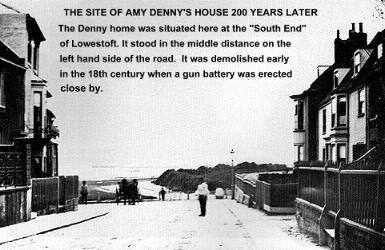It is ironic and n
ot a little sad that the author of the published report could not get Amy's name right! The report calls her Amy Duny but on the indictments she is named as Amy Denny - a surname very common in the Lowestoft area.
Very little is known about Amy or her family. There is no record of her birth or marriage in the Lowestoft records. The Parish registers carry only one entry directly related to her, this records the baptism of a child, Samuel, on 11 May 1651. From this we learn that her husband's name was John. It is safe to assume that neither Amy or her husband were "natives" of Lowestoft.
The parish registers note the burial of a John Denny in Lowestoft in January 1657. This is probably Amy's husband, for she was a widow when the trial took place.
There is a possibility that Amy and her husband originated from the market town of Beccles, eight miles west of Lowestoft. The parish registers here record the marriage of John Denny to Emma Heckleton in October 1634. "Amy" is a common pet form of Emma, being a corruption of "Emmy". One of the most damning allegations made against Amy Denny was that she was related to a known witch. During the great witch hunt led by Matthew Hopkins, the self-styled "Witchfinder General", in 1645 a woman by the name of Margaret Eccleston from the village of Linstead, nine miles south of Beccles, was accused of being a witch and found guilty. Given the vagaries of 17th century spelling this woman might have been related to Emma (Amy) Heckleton. This of course is all very tenuous and speculative.
John and Amy Denny had three children baptised at Beccles, the last being in 1642, after that they disappear from the Beccles records. However, just two years later the name John Denny suddenly occurs with great frequency in the Manor Court Books of Lowestoft. The Court Baron, which met monthly dealt mainly with the transfer of Copyhold property but it also adjudicated suits involving injuries, trespass and debt not exceeding 40 shillings.
Between November 1644 and December 1653 the name John Denny appears no less that 69 times, all but three of then as defendant. No other person's name appears with such regularity as that of John Denny. Unfortunately, because the court records only contain the names of the plaintiff and the defendant, together with the verdict, it is impossible to say why Denny was brought to court so many times, except that he must have exhibited incredible "anti-social" tendencies towards all and sundry in Lowestoft! The court records are missing between 1653 and 1667, when they resume the name John Denny is conspicuous by its absence.
There were two adult males named John Denny living in Lowestoft at this time so there is an even chance that the one who appeared before the Manor Court was Amy's husband, more so because the "other" John Denny was born and raised in the town but the name doesn't appear before 1644.
If Amy's husband (or his family) did consistently cause civil injuries to their neighbours, perhaps this was one source of the vindictiveness against Amy that led to her untimely demise on the gallows as a "witch".
Amy Denny rented a sub-divided house at the extreme southern end of town. This house was owned by Cornelius Landefielde, whose wife Anne gave evidence against her at her trial, some of which was centered on the "bewitching" of this property.
What little is known about Amy Denny is speculative, but whatever the truth, there is no possible reason why she should have been accused and executed for "crimes" she could not have committed . . . . .
Sources:Lowestoft Parish Registers. Suffolk Record Office, Lowestoft.
Beccles Parish Registers. Suffolk Record Office, Lowestoft [FC3/D2/11].
Lowestoft Manor Court Books. Suffolk Record Office, Lowestoft [194/A10/8 & 9].
The Examination of the Witches - August 1645 [British Museum. Add. MS 27402. fos. 104-121].
